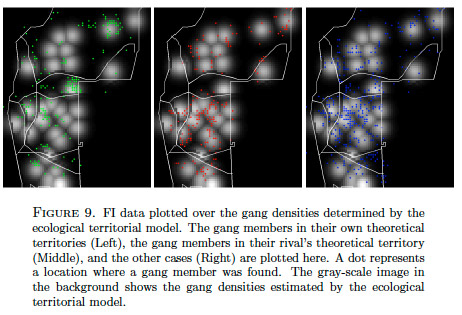
If you've been following some of the details of the spike in homicides this summer in Chicago, you've probably heard a bit about gang factions and gangs. For instance:
McCarthy’s citywide gang audit, completed in May, shows that Chicago now has 59 active street gangs with 625 factions. That’s up from 500 factions and 68 gangs in 2003. This continued fracturing of the local gangs, McCarthy believes, is the reason for the rash of recent violence.
The splintering stems from a lack of leadership; many of the highest-ranking chiefs are in prison or dead. “We took the generals out, and we now have the gangs being run by sergeants,” explains Leo Schmitz, the commander of the Englewood District (7th). “Instead of having an area, now they have blocks.” This means increased rivalry—and, as a result, more shootings.
Schmitz describes an adversary who is younger, more reckless, and more likely to pull a trigger. “Young people are making very quick decisions,” he says, “and most of the time they are the wrong ones.”
Today in the Trib Jeremy Gormer has much more on this theory, and talks to one of the criminologists who's been an influence on Garry McCarthy:
"You're more likely, just by general sociological laws, to come into conflict with people who are next to you," said Andrew Papachristos, a sociologist at Yale University who is working on a book about the Gangster Disciples.
"So if you're around four other (gang) sects and you're no longer partying with them on a daily basis," he said, "those conflicts will be more likely to erupt because you don't have that grand poobah telling you what to do anymore."
Research into Chicago's gun markets suggests that the grand poobahs do exert some control over the rank and file, keeping a firm hand on the gang's weapons and only doling them out for the purpose of gang business, in order to keep less-trustworthy members from doing things outside the gang's interest. But it also reminded me of an interesting paper that came out earlier this year, that modeled LA violence along gang territory and found that it fits with other models of territorial conflict:
A mathematical model that has been used for 80 years to determine the hunting range of wild animals has been reappropriated for use in mapping gang territories in urban environments.
A UCLA-led team of social scientists has used the model to assess where the most dangerous places are in a neighbourhood packed with gangs. The research — published in Criminology — shows that it is the gang territory borders rather than the heart of a specific gang's territory where the most conflict occurs. The majority of conflict takes place within less than two blocks of gang boundaries. The results surprised researchers, as they had assumed that the model would have been too simplistic to account for human behaviour.
So this—"it is the gang territory borders rather than the heart of a specific gang's territory where the most conflict occurs"—shouldn't be that much of a surprise. If you're in Gang A, you would obviously spend as little time as possible in Gang B's territory because that would be an extremely stupid thing to do. My reaction was that it's less a reflection of the idea that we're all just animals than that territory is physical and is thus subject to physical limitations. So consider this possibility in the context of gang fracturing and splintering (back to Gormer's piece):
Neighborhoods like Chicago Lawn and Marquette Park might be populated by a few dozen factions, police said. Each probably has 15 to 20 followers, said Rafi Peterson, a community activist who works with gangs in the district.
"They're not just geographically tied down. They might be in a car. They might go to a party over here. But then they're representing this little clique over there," Peterson said. "And what happens? They're gunning each other wherever they catch each other."
If these factions have territory, it's smaller, so there's more (for lack of a better term) gang surface area, which suggests more conflict. If they don't have territory, if they're not "geographically tied down," that's more conflict still. And it's not predictable in the way that the UCLA scientists found in Los Angeles. McCarthy has cited this fracturing as a difficulty for the CPD, but it's not hard to imagine the effect it has on gang members as well, floating in the same fluid, violent territories, and the implications of that unpredictability on fateful decisions.
Image: From Adaptation of an Ecological Territorial Model to Street Gang Spacial Patterns in Los Angeles [PDF]


